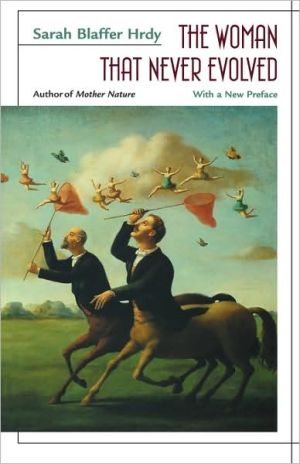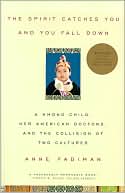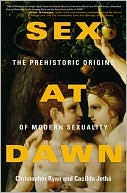The Woman That Never Evolved: With a New Preface and Bibliographical Updates, Revised Edition
What does it mean to be female? Sarah Blaffer Hrdy—a sociobiologist and a feminist—believes that evolutionary biology can provide some surprising answers. Surprising to those feminists who mistakenly think that biology can only work against women. And surprising to those biologists who incorrectly believe that natural selection operates only on males.\ In The Woman That Never Evolved we are introduced to our nearest female relatives competitive, independent, sexually assertive primates who...
Search in google:
What does it mean to be female? Sarah Blaffer Hrdy—a sociobiologist and a feminist—believes that evolutionary biology can provide some surprising answers. Surprising to those feminists who mistakenly think that biology can only work against women. And surprising to those biologists who incorrectly believe that natural selection operates only on males.In The Woman That Never Evolved we are introduced to our nearest female relatives competitive, independent, sexually assertive primates who have every bit as much at stake in the evolutionary game as their male counterparts do. These females compete among themselves for rank and resources, but will bond together for mutual defense. They risk their lives to protect their young, yet consort with the very male who murdered their offspring when successful reproduction depends upon it. They tolerate other breeding females if food is plentiful, but chase them away when monogamy is the optimal strategy. When "promiscuity" is an advantage, female primates—like their human cousins—exhibit a sexual appetite that ensures a range of breeding partners. From case after case we are led to the conclusion that the sexually passive, noncompetitive, all-nurturing woman of prevailing myth never could have evolved within the primate order.Yet males are almost universally dominant over females in primate species, and Homo sapiens is no exception. As we see from this book, women are in some ways the most oppressed of all female primates. Sarah Blaffer Hrdy is convinced that to redress sexual inequality in human societies, we must first understand its evolutionary origins. We cannot travel back in time to meet our own remote ancestors, but we can study those surrogates we have—the other living primates. If women —and not biology—are to control their own destiny, they must understand the past and, as this book shows us, the biological legacy they have inherited. Jane B. Lancaster - American Journal of Physical Anthropology The bulk of the book represents an attempt to create a perspective on the evolutionary biology of women by evaluating their female primate heritage. These chapters are original, high quality formulations presenting and explaining the behavior of female primates using a combination of sociobiological and socioecological principles of analysis...The book is written toward a borderline between the scientific and the popular audience--not an easy thing to do--but, by and large, Hrdy does just that. For this reason, the book has a place in both research and teaching.
Preface, 1999: On Raising Darwin's Consciousness1Some Women That Never Evolved12An Initial Inequality163Monogamous Primates: A Special Case344A Climate for Dominant Females595The Pros and Cons of Males726Competition and Bonding among Females967The Primate Origins of Female Sexuality1318A Disputed Legacy160Afterword189Taxonomy of the Primate Order193Notes200Bibliographical Updates, 1999243Index253
\ American Journal of Physical AnthropologyThe bulk of the book represents an attempt to create a perspective on the evolutionary biology of women by evaluating their female primate heritage. These chapters are original, high quality formulations presenting and explaining the behavior of female primates using a combination of sociobiological and socioecological principles of analysis...The book is written toward a borderline between the scientific and the popular audience—not an easy thing to do—but, by and large, Hrdy does just that. For this reason, the book has a place in both research and teaching.\ — Jane B. Lancaster\ \ \ \ \ \ American ScientistThis is a splendid book. It is a scientific treatise on primate sex and status, successfully masquerading as a good read.\ — Alison Jolly\ \ \ \ Ethnology and SociologyIt is an understatement to say that this is a provocative essay. Although the book is written for a general audience, it will compel specialists to reconsider many of their assumptions about the evolution of primate females. Those interested in evolutionary influences upon human social behavior will be stimulated and challenged. Undoubtedly, many of the hypotheses will be controversial, and some may be disturbing.\ — Joan B. Silk\ \ \ \ \ \ O Magazine[A] breakthrough book...A primatologist by training and feminist by predilection, Hrdy asked the basic and in my mind perfectly sensible question: How do women compare to other female primates? What can we understand about our urges, desires, and fears, our sexuality, our relationships with men and with other women, and the near universality of women's second-class status, by examining the lives and loves of our closest nonhuman kin? Among Hrdy's many bracing conclusions: Far from being coy and sexually tepid, as the stereotype has it, women may well have evolved for a restless sort of promiscuity, the better to confuse issues of paternity and thus heighten their children's chances of survival in the hazardous, half-cocked company of men.\ — Natalie Angier\ \ \ \ \ \ ScienceIn its treatment of primate behavior, Hrdy's book has no peers...[It is] a fascinating account of the selective pressures that have shaped the behavior of males and females.\ — Dorothy Cheney\ \ \ \ \ \ BooknewsArguing that while humans are the extreme case of sexual sophistication, they are by no means a unique one, Hrdy (anthropology, U. of California), surveys the sexual habits of female primates in an effort to debunk the conception that women are by nature monogamous and men polygamous. She finds that female primates have a diversity of sexual habits, often tending towards the bold solicitation of many partners. In a final chapter she explores the social construction of sexuality in human societies and argues that the monogamous/polygamous distinction is false one forced upon women by the dictates of patrimony. Annotation c. Book News, Inc., Portland, OR (booknews.com)\ \








